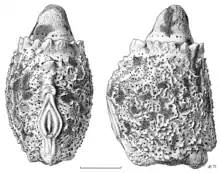| Pseudoclitarchus | |
|---|---|
_Male_specimen.jpg.webp) | |
| Pseudoclitarchus sentus (Salmon, 1948), male specimen held at Auckland Museum, licensed under CC BY 4.0 | |
_Female_specimen_AMNZ55078.jpg.webp) | |
| Pseudoclitarchus sentus (Salmon, 1948), female specimen held at Auckland Museum, licensed under CC BY 4.0 | |
| Scientific classification | |
| Domain: | Eukaryota |
| Kingdom: | Animalia |
| Phylum: | Arthropoda |
| Class: | Insecta |
| Order: | Phasmatodea |
| Family: | Phasmatidae |
| Subfamily: | Phasmatinae |
| Tribe: | Acanthoxylini |
| Genus: | Pseudoclitarchus Salmon, 1991[1] |
| Species: | P. sentus |
| Binomial name | |
| Pseudoclitarchus sentus (Salmon, 1948) | |
| Synonyms[2] | |
| |
Pseudoclitarchus sentus is the sole representative of the genus Pseudoclitarchus, and is a stick insect endemic to the Three Kings Islands. It lives mainly on kanuka trees.[3]

Illustration of Pseudoclitarchus senta egg by Des Helmore
References
- ↑ Salmon, J. T. (1991). The stick insects of New Zealand. Birkenhead, Auckland: Reed. pp. 1–124. ISBN 0790002116.
- ↑ "Catalogue of Life : Pseudoclitarchus sentus (Salmon, 1948)". www.catalogueoflife.org. Catalogue of Life. Retrieved 27 August 2016.
- ↑ "Pseudoclitarchus Salmon". Landcare Research. Landcare Research. Retrieved 22 December 2015.
![]() Data related to Pseudoclitarchus at Wikispecies
Data related to Pseudoclitarchus at Wikispecies
This article is issued from Wikipedia. The text is licensed under Creative Commons - Attribution - Sharealike. Additional terms may apply for the media files.